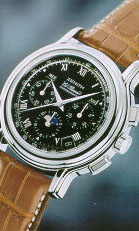The Zenith-Movado El Primero Beethoven had his late quartets, Dostoevski his "Brothers Karamazov." Mechanical watchmaking had something akin to these masterpieces, both completed in their creators' last years and more sophisticated than anything they'd done before. It was called El Primero, and it represented a final, magnificent flourish of mechanical technology before mechanical watches were eclipsed, although only temporarily, by quartz ones. Beethoven had his late quartets, Dostoevski his "Brothers Karamazov." Mechanical watchmaking had something akin to these masterpieces, both completed in their creators' last years and more sophisticated than anything they'd done before. It was called El Primero, and it represented a final, magnificent flourish of mechanical technology before mechanical watches were eclipsed, although only temporarily, by quartz ones.
It was the late '60's. Change was in the air. Before the decade was over, Seiko would bring the world's first quartz watch to market. Consumers were itching for new, modern ways of telling time. They'd been snapping up Bulova Accutrons and other electronic tuning-fork watches since 1960 and were just waiting for the next big thing. Given the direction the market was moving in, that thing would almost certainly be electronic. What were makers of ho-hum, mechanical watches to do? In 1969, just months before Seiko launched the world's first quartz watch, a joint venture between Movado and Zenith came up with something they hoped would keep them in the game: the world's first automatic chronograph. It hadn't been easy. For years manufacturers had been looking for a way to incorporate an automatic winding system into the complex workings of a chronograph movement. Thanks to a special microrotor, the Zenith-Movado venture finally did so. Not only did it have an automatic chronograph, it also had a date indicator. It was a very impressive feat of engineering. Their watch, which they marketed under both the Zenith and Movado labels, had another added attraction, a balance that beat at a very fast 36,000 vibrations per hour. That made it more accurate than standard mechanical watches and nearly as precise, in some instances, as tuning-fork ones. Despite its perseverance and expertise, Zenith-Movado almost got beaten to the finish line. A team composed of Heuer, Brietling, Dubois Depraz and Hamilton-Buren (America's Hamilton Watch Co. had bought the Swiss company Buren in 1966) was working on the same project. The two competitors launched their watches within a hair's breadth of each other, but history gave the victory to Zenith-Movado. Zenith-Movado accepted it, naming their watch "El Primero" - "the first" - in honor of its first-place, albeit photo, finish. |
